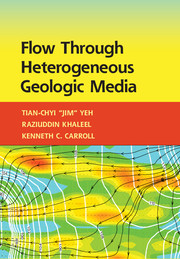Book contents
- Frontmatter
- Contents
- Preface and Acknowledgments
- 1 Fluid Statics and Dynamics
- 2 Darcy's Law for Saturated Porous Media
- 3 Darcy's Law for Unsaturated Porous Media
- 4 Stochastic Conceptualization of Heterogeneity
- 5 Governing Flow Equations for Heterogeneous Media Conceptual Models
- 6 Equivalent Homogeneous Media Conceptual Models
- 7 Flow toward a Well Due to Pumping (Part 1)
- 8 Flow toward a Well Due to Pumping (Part 2)
- 9 Stochastic Approaches
- References
- Index
9 - Stochastic Approaches
Published online by Cambridge University Press: 05 July 2015
- Frontmatter
- Contents
- Preface and Acknowledgments
- 1 Fluid Statics and Dynamics
- 2 Darcy's Law for Saturated Porous Media
- 3 Darcy's Law for Unsaturated Porous Media
- 4 Stochastic Conceptualization of Heterogeneity
- 5 Governing Flow Equations for Heterogeneous Media Conceptual Models
- 6 Equivalent Homogeneous Media Conceptual Models
- 7 Flow toward a Well Due to Pumping (Part 1)
- 8 Flow toward a Well Due to Pumping (Part 2)
- 9 Stochastic Approaches
- References
- Index
Summary
Introduction
This chapter synthesizes the materials from all previous chapters to present a unified approach for analyzing groundwater flow through heterogeneous geologic media. The first part examines necessary conditions for mathematical (or numerical) models to be well defined such that a mathematically unique solution can be obtained. These mathematical models include those for prediction of groundwater flow – forward problems – and those for estimation of hydraulic properties of geologic media using their responses – inverse problems.
While the necessary conditions for real-world problems to be mathematically well defined can be collected and specified, the collected or specified conditions always involve uncertainty. Because of this uncertainty, the true solution to the problem is unknown (i.e., there are many possible solutions). As a result, stochastic methods to the forward and inverse problems are introduced in this chapter for deriving the statistically most likely solution, and quantifying its uncertainty. These stochastic techniques are grouped into two categories: unconditional and conditional approaches. The unconditional approach, which does not necessarily honor spatial or temporal observations at the sampled locations, includes the unconditional effective parameter and the Monte Carlo simulation methods. Both of them aim to provide unbiased estimates of the model parameters and predictions for flow field but at low resolutions. On the other hand, the conditional approach honors the observations and provides statistically unbiased and high resolution estimates of model parameters and predictions for the flow field. This approach is comprised of conditional effective parameter and conditional Monte Carlo simulation methods. In addition to discussion of these methods, a first-order analysis is presented for analyzing uncertainty in predicted heads and for studying the relationship between the observed head and parameters of the flow model. This relationship is the basis of the conditional methods, and it is used to explain the shortcomings of the unconditional effective parameter methods.
Conditional stochastic estimators (i.e., kriging and cokriging, successive linear estimator), which fuse the same or different types of information, are discussed next. At the end of this chapter, we discuss methods (i.e., hydraulic tomography) that collect nonredundant data sets in a cost-effective manner for reducing aquifer characterization uncertainties.
Well-Defined and Ill-Defined Forward and Inverse Problems
A forward problem here entails solving the governing flow equations for head in time and space over a solution domain (i.e., a basin or an arbitrarily defined field site), with given model input parameters, and boundary and initial conditions.
- Type
- Chapter
- Information
- Flow through Heterogeneous Geologic Media , pp. 289 - 329Publisher: Cambridge University PressPrint publication year: 2015



